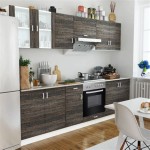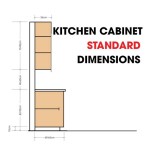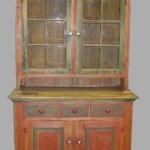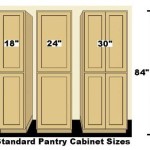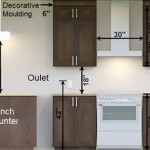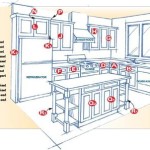Refinishing Pickled Oak Kitchen Cabinets
Pickled oak kitchen cabinets were a popular design choice for many years, characterized by their light, pinkish-white hue achieved through a specific staining process. However, as interior design trends evolve, homeowners often find themselves wanting to update the look of their kitchens and transform these cabinets to better align with modern styles. Refinishing pickled oak cabinets is a viable option, albeit a process requiring careful planning, execution, and the right materials. This article details the steps involved in successfully refinishing pickled oak kitchen cabinets, offering insights into achieving a desired aesthetic while preserving the structural integrity of the cabinets.
The inherent challenge in refinishing pickled oak lies in the open grain of the oak wood and the nature of the pickling stain itself. This stain is designed to highlight the grain, penetrating deeply into the wood pores. Successfully covering this stain and achieving a smooth, uniform finish requires thorough preparation and the selection of appropriate primers and topcoats. Ignoring these crucial aspects can lead to unsatisfactory results, such as stain bleed-through, uneven color, or poor adhesion of the new finish.
Preparing Pickled Oak Cabinets for Refinishing
The preparation phase is the most critical step in refinishing pickled oak cabinets. This stage determines the overall success of the project, influencing the adhesion of subsequent layers and the final appearance of the refinished surface. The preparation involves cleaning, degreasing, sanding, and potentially priming the cabinets. A meticulous approach during this stage lays the foundation for a professional-looking and durable finish.
The initial step is a thorough cleaning. Years of accumulated grease, grime, and dust can inhibit the adhesion of any new finish applied to the cabinets. Using a degreasing cleaner specifically designed for kitchen surfaces is recommended. These cleaners effectively remove contaminants without damaging the wood. The cabinets should be scrubbed with a non-abrasive sponge or cloth, ensuring all surfaces, including corners and crevices, are thoroughly cleaned. After cleaning, the cabinets should be rinsed with clean water and allowed to dry completely. The drying time can vary depending on the humidity and temperature of the environment, but typically requires several hours or overnight.
Following the cleaning process, the next step is sanding. Sanding roughens the surface, creating a mechanical bond for the primer and paint to adhere to. It also helps to remove any loose or flaking finish and smooth out imperfections. The grit of sandpaper used is crucial. Starting with a coarser grit, such as 120-grit, can help remove the existing pickled finish more effectively. However, excessive sanding with coarse grits can damage the wood. A balance needs to be struck between removing the old finish and preserving the integrity of the wood. After the initial sanding, progress to a finer grit, such as 220-grit, to smooth out the surface and remove any sanding marks left by the coarser grit.
Power sanders, such as orbital sanders, can expedite the sanding process, but caution should be exercised to avoid over-sanding or damaging the wood. Hand sanding is often preferred for intricate details and hard-to-reach areas. Regardless of the method used, it is essential to sand with the grain of the wood to prevent scratching. After sanding, thoroughly remove all sanding dust with a vacuum cleaner and a tack cloth. Even small amounts of dust can compromise the adhesion of the primer and paint.
After sanding and cleaning, the application of a primer is often recommended, especially when dealing with pickled oak. Priming serves several purposes: it seals the wood, prevents stain bleed-through from the old finish, and provides a uniform surface for the topcoat to adhere to. Oil-based primers are generally considered more effective at blocking stains than water-based primers. However, oil-based primers require mineral spirits for cleanup and emit stronger odors. Water-based primers are easier to clean up and have lower VOC (volatile organic compounds) emissions. The choice of primer depends on the desired level of stain blocking, the type of topcoat to be used, and personal preference.
Regardless of the primer chosen, it should be applied in thin, even coats, following the manufacturer's instructions. Multiple thin coats are preferable to one thick coat, as they are less likely to drip or sag. Allow the primer to dry completely between coats. After the primer has dried, lightly sand it with a fine-grit sandpaper (e.g., 320-grit) to smooth out any imperfections and create a better surface for the topcoat to adhere to. Again, remove all sanding dust before proceeding.
Selecting the Right Paint and Application Techniques
The selection of the right paint and application techniques is paramount in achieving a durable and aesthetically pleasing finish on refinished pickled oak cabinets. The type of paint, sheen level, and application method all contribute to the final result. Choosing the appropriate materials and employing proper techniques can significantly enhance the longevity and appearance of the refinished cabinets.
There are primarily two types of paint suitable for kitchen cabinets: latex (water-based) and oil-based paints. Latex paints have improved significantly in recent years and offer several advantages, including easy cleanup, low odor, and flexibility, which helps prevent cracking and chipping. Oil-based paints are known for their durability and smooth finish, but they require mineral spirits for cleanup and emit stronger odors. The choice between latex and oil-based paint often depends on personal preference and the desired level of durability. Acrylic latex paints, in particular, are a popular choice for kitchen cabinets due to their excellent adhesion, durability, and resistance to mildew and moisture.
The sheen level of the paint also affects the appearance and durability of the finish. Sheen refers to the amount of light reflected by the paint. Flat or matte finishes have the lowest sheen and are good at hiding imperfections, but they are not as durable or easy to clean as higher sheen levels. Semi-gloss and gloss finishes have the highest sheen and are the most durable and easiest to clean, but they can highlight imperfections. Satin and eggshell finishes offer a good balance between durability and hiding imperfections. For kitchen cabinets, a satin or semi-gloss finish is generally recommended, as they provide good durability and are easy to wipe clean.
The application method also plays a crucial role in the final result. Paint can be applied using brushes, rollers, or sprayers. Brushes are suitable for small areas and intricate details, but they can leave brush marks if not used properly. Rollers are good for large, flat surfaces, but they can create a textured finish. Sprayers provide the smoothest finish, but they require more skill and equipment to use effectively. If using a brush, choose a high-quality brush designed for the type of paint being used. Use smooth, even strokes, and avoid applying too much paint at once. "Laying off" the paint, which involves lightly brushing over the wet paint in the direction of the grain, can help minimize brush marks.
When using a roller, choose a roller cover with a nap appropriate for the paint and surface. A shorter nap is generally better for smooth surfaces, while a longer nap is better for textured surfaces. Apply the paint in thin, even coats, overlapping each stroke slightly to avoid gaps. If using a sprayer, thin the paint according to the manufacturer's instructions. Adjust the sprayer settings to achieve a consistent spray pattern. Apply the paint in thin, even coats, overlapping each coat slightly. Regardless of the application method used, multiple thin coats are always preferable to one thick coat. Allow each coat to dry completely before applying the next coat. Lightly sand between coats with a fine-grit sandpaper (e.g., 320-grit) to smooth out any imperfections and create a better surface for the next coat to adhere to. Remove all sanding dust before proceeding.
Considerations for Hardware and Reassembly
The final stage of refinishing pickled oak kitchen cabinets involves the reinstallation of hardware and reassembly of the cabinets. This step is crucial for completing the transformation and ensuring the cabinets function properly. Careful attention to detail during this phase can enhance the overall aesthetic and usability of the kitchen.
Before beginning the refinishing process, all hardware, including knobs, pulls, hinges, and latches, should be removed from the cabinets. This allows for thorough cleaning, sanding, and painting of the cabinet surfaces. The hardware should be stored in a safe place to prevent damage or loss. Consider labeling the hardware according to the cabinet door or drawer it belongs to, to make reassembly easier.
While the cabinets are being refinished, consider cleaning or replacing the hardware. Cleaning the hardware can often restore its original shine and luster. Use a mild soap and water to remove any dirt or grime. For tarnished hardware, a metal polish can be used to restore the finish. If the hardware is damaged or outdated, consider replacing it with new hardware that complements the new cabinet finish. New hardware can significantly update the look of the kitchen and enhance the overall aesthetic.
After the paint has completely dried and cured, the hardware can be reinstalled. Use the original screws or bolts, unless they are damaged or stripped. If necessary, replace the screws or bolts with new ones of the same size and type. When reinstalling the hardware, be careful not to scratch or damage the new finish. Use a screwdriver with a properly sized head to avoid stripping the screws. Avoid over-tightening the screws, as this can damage the wood. If the screw holes are stripped, use wood glue and toothpicks or wooden dowels to fill the holes before reinstalling the screws.
Once the hardware is reinstalled, the cabinet doors and drawers can be reattached to the cabinet frames. Ensure that the hinges are properly aligned and that the doors and drawers open and close smoothly. Adjust the hinges if necessary to ensure proper alignment. If the cabinets have soft-close hinges, ensure that they are functioning properly. After reassembling the cabinets, inspect the finish for any imperfections. Touch up any scratches or blemishes with a small brush and the original paint. Allow the touch-up paint to dry completely before using the cabinets.

Mauve Schmauve Reducing The Pink Of Pickled Oak Cabinets Table And Hearth

How Do I Re Pickle Oak Kitchen Cabinets Is There An Easy Way Hometalk

19 Pickled Oak Cabinets Ideas Kitchen

Mauve Schmauve Reducing The Pink Of Pickled Oak Cabinets Table And Hearth

Pickled Oak Cabinets Has Me In A Pickle Over Wall Color

Mauve Schmauve Reducing The Pink Of Pickled Oak Cabinets Table And Hearth

Kitchen Cabinet Remake Pickled To Beachy Hometalk

Kitchen Remodel Before After Country Cabinets White Oak

Wood N Finish Cabinet Kit Grained Pickled Oak Retique It

Embracing Pickled Oak
Related Posts

